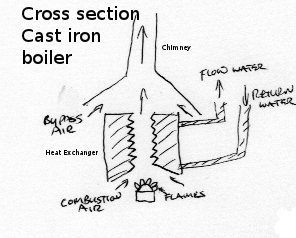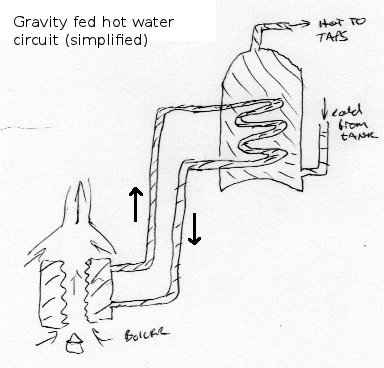Governments have put in place boiler scrappage schemes and offer other incentives to replace these cast iron boilers with more modern boilers, which promise better efficiency, but come with the suspicion of being less durable and less reliable. Due to the long life and reliability of the old design, many have resisted the incentives to replace the old boiler.
With an engineering background, and having had experience of heating and plumbing, I wanted to check whether the efficiency of SEDBUK band G boilers are more or less efficient than the stated 65% G SEDBUK rating. Particularly for heating a hot water cylinder.
It occurred to me that we can calculate the system efficiency when providing hot water easily. This wouldn't be so easy for central heating, but measuring system efficiency for hot water will give a ball park figure which can also be applied for central heating.
A typical cast iron boiler-based hot water system will consist of a hot water cylinder, typically lagged, located in an airing cupboard, on an upper (first) floor. A cast iron boiler, either wall or floor mounted would be positioned lower than the cylinder. Typically on the ground floor. The cast iron boiler may either share pipes with the central heating, in which case, the hot water circuit will be pumped and have a 3 port motorised zone valve, or the heating and hot water systems will be separate, in which case, the boiler will have two flow and two return connections used, and the water will circulate to the heat exchanger in the hot water tank through gravity; the heated water will be lower density so will tend to flow upwards through the pipework towards the hot water cylinder.


Determining the overall system efficiency when heating hot water is simple. We measure the dimensions of the hot water cylinder then use that to calculate the volume, hence weight of water being heated. We measure the starting temperature of the water, the finishing temperature of the water. From that we can calculate actual heat energy that has entered the hot water tank. We can compare that to the gas used at the meter. By knowing the heating value of the gas, we can accurately determine system efficiency.
I used this specific system not through selection, but because it is a system that is currently available to me, and is a good example of an open flue cast iron boiler, gravity hot water, pumped central heating system. Hot water tank capacity: 70 litres to just above the lowest part of the coiled in-tank heat exchanger. Pipes between boiler and hot water tank: 22mm. Rise 3.4m, horizontal run 2.6m. Given the rise is greater than the run, this would suggest a good rate of flow for a gravity fed system, which should improve efficiency slightly. Boiler type: Baxi Bermuda 401 conventional flue back boiler on middle setting 8.6Kw, with airbrick in room.
The primary water flow temperature set to 80 centigrade. This was selected to provide an adequate temperature gradient across the tank heat exchanger to achieve the required target 60 centigrade in reasonable time, and would be a standard set-up for such a system. The starting temperature of the water in the tank was as low as I could get, flushing hot water out from the system. This would bias the test results in favour of higher efficiency. Higher thermal gradients favour faster heat exchange.
Initially, test 1 was deemed a failure, as heat 'leaked' from the gravity hot water system into the upstairs radiators. Test 2 was carried out with the lockshield valves closed in all radiators to prevent heat leakage. Given most householders won't close the lockshield valves on radiators, and the boiler is the only way to heat the hot water tank, you may consider this test the more valid result, as the heat leaking into the radiators in the summer would be unwanted, and therefore wasted. This problem would occur only on a gravity fed system, as a fully pumped system would implement a zone valve, thereby shutting off all radiators when the hot water is being heated. The experiment was aborted when it was noticed upstairs radiators were hot. Therefore, the hot tank final temperature is 50 centigrade.
Water in cylinder, Mass: 70Kg Water in cylinder, starting temperature: 11 centigrade Water in cylinder, ending temperature: 50 centigrade Water in cylinder, specific heat capacity: 4.2Kj/kilogram centigrade Water in cylinder, total energy absorbed: (50-11)*4.2*70 = 11,466 Kilojoules, or 3.185Kwh Gas meter start, end cubic meters 3645.625 3646.851 use: 1.226 Cu.m Gas energy value: 11Kwh/Cu.m Experiment run time: 2 hours Gas energy used: 13.486Kwh Overall system efficiency: 3.185 / 13.486 = 23.6%
Conclusion: Although the boiler has a quoted energy efficiency rating of 65%, the actual achieved system efficiency when considering heat leaking into radiators as waste heat, is only 23.6%. If the full tank of water isn't used, the efficiency rating would be lower still.
Test procedure as test 1, except leakage into radiators was prevented. Steps normal householder wouldn't take. This should be taken as a good indication of actual boiler efficiency under good conditions.
Water in cylinder, Mass: 70Kg Water in cylinder, starting temperature: 12 centigrade Water in cylinder, ending temperature: 60 centigrade Water in cylinder, specific heat capacity: 4.2Kj/kilogram centigrade Water in cylinder, total energy absorbed: (60-12)*4.2*70 = 14,112 Kilojoules, or 3.92Kwh Gas meter start, end cubic meters 3647.451 3648.598 use: 1.147 Cu.m Gas energy value: 11Kwh/Cu.m Experiment run time: 2 hours 15 minutes Gas energy used: 12.61Kwh Overall system efficiency: 3.92 / 12.617 = 31%
These results show that an open flue cast iron boiler may provide an efficiency of less than half the quoted 65% industry accepted SEDBUK efficiency rating. The rating isn't individually assessed, and may be somewhat optimistic. Around 1 Kwh of gas heat was used to bring the cold boiler to functioning temperature. This heat will be totally lost up the chimney soon after the boiler has done it's job heating the hot water tank (or radiators). On older boilers which don't use fan assisted flues, convection currents continue through the boiler heat exchanger whether or not the flames are lit. This results in substantial heat loss from the boiler when not on full demand, as is typical when heating hot water, or on systems where thermostatic radiator valves are used. This is because the boiler heat exchanger is kept hot longer so loses more heat. Another factor to consider is that an open flue boiler located in a dwelling requires adequate ventilation, often in the form of an airbrick. This ventilation must not be controllable. This leads to another source of heat loss and draught, further lowering overall system efficiency. Conventional boilers also tend to use pilot lights. Small flames constantly lit - another non-trivial source of energy loss.
The same problems of rapid heat loss from boiler heat exchanger aren't a major concern for boilers which use a fan assisted flue, as the flue tends to have a significant resistance to natural convected air flow. Also, modern condensing combi boilers can be operated with a much lower heating water temperature, improving overall heat exchange and system efficiency.